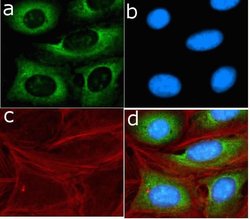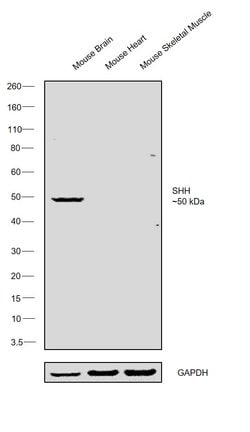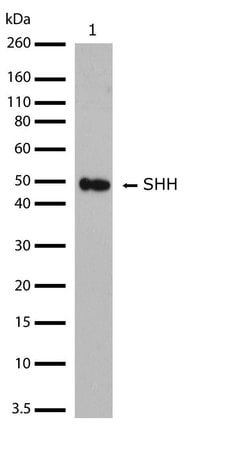Learn More
Invitrogen™ SHH Recombinant Rabbit Monoclonal Antibody (23H15L1)
Rabbit Recombinant Monoclonal Antibody
Supplier: Invitrogen™ 701403
Description
This antibody is predicted to react with canine, non-human primate, mouse, rabbit, rat and porcine based on sequence homology. Intact IgG appears on a non-reducing gel as ~150 kDa band and upon reduction generating a ~25 kDa light chain band and a ~50 kDa heavy chain. Recombinant rabbit monoclonal antibodies are produced using in vitro expression systems. The expression systems are developed by cloning in the specific antibody DNA sequences from immunoreactive rabbits. Then, individual clones are screened to select the best candidates for production. The advantages of using recombinant rabbit monoclonal antibodies include: better specificity and sensitivity, lot-to-lot consistency, animal origin-free formulations, and broader immunoreactivity to diverse targets due to larger rabbit immune repertoire.
Sonic Hedgehog (SHH), which is expressed only during embryogenesis, is instrumental in patterning the early embryo. It has been implicated as the key inductive signal in patterning of the ventral neural tube, the anterior-posterior limb axis, and the ventral somites. Of three human proteins showing sequence and functional similarity to the Sonic Hedgehog protein of Drosophila, this protein is the most similar. The protein is made as a precursor that is autocatalytically cleaved, the N-terminal portion is soluble and contains the signalling activity while the C-terminal portion is involved in precursor processing. More importantly, the C-terminal product covalently attaches a cholesterol moiety to the N-terminal product, restricting the N-terminal product to the cell surface and preventing it from freely diffusing throughout the developing embryo. Defects in this protein or in its signalling pathway are a cause of holoprosencephaly (HPE), a disorder in which the developing forebrain fails to correctly separate into right and left hemispheres. HPE is manifested by facial deformities. In addition, it is thought that mutations in this gene or in its signalling pathway may be responsible for VACTERL syndrome, which is characterized by vertebral defects, anal atresia, tracheoesophageal fistula with esophageal atresia, radial and renal dysplasia, cardiac anomalies, and limb abnormalities.
Specifications
| SHH | |
| Recombinant Monoclonal | |
| 0.5 mg/mL | |
| PBS with 0.09% sodium azide | |
| Q15465, Q62226 | |
| Shh | |
| Peptide corresponding to amino acids 173-184 of human SHH. | |
| 100 μg | |
| Primary | |
| Human, Mouse | |
| Antibody | |
| IgG |
| Western Blot, Immunocytochemistry | |
| 23H15L1 | |
| Unconjugated | |
| Shh | |
| 9530036O11Rik; Dsh; fc83d08; hedgehog; hemimelic extra toes; Hhg1; HHG-1; HLP3; HPE3; Hx; Hxl3; M100081; MCOPCB5; morphogen; shh; Shh N-terminal processed signaling domains; Shh unprocessed N-terminal signaling and C-terminal autoprocessing domains; shh.L; shha; ShhN; ShhNC; ShhNp; short digits; SMMCI; sonic hedgehog; sonic hedgehog a; sonic hedgehog homolog; sonic hedgehog L homeolog; sonic hedgehog protein; Sonic hedgehog protein 19 kDa product; Sonic hedgehog protein A; Sonic hedgehog protein A N-product; Sonic hedgehog protein N-product; sonic hedgehog signaling molecule; sonic hedgehog signaling molecule a; sonic-you; syu; TPT; TPTPS; vhh1; vhh-1; wu:fc83d08; XELAEV_18030676mg; Xhh; xshh; X-SHH | |
| Rabbit | |
| Protein A | |
| RUO | |
| 20423, 6469 | |
| Store at 4°C short term. For long term storage, store at -20°C, avoiding freeze/thaw cycles. | |
| Liquid |
Your input is important to us. Please complete this form to provide feedback related to the content on this product.



